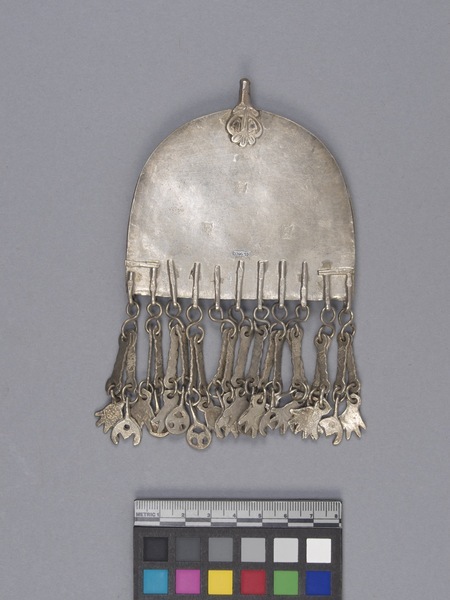Pendant Item Number: 3395/10 from the MOA: University of British Columbia


Description
Semi-circular pendant with a string of red beads strung through metal rings set within a semi-circular channel that borders the edge. There is a single ring at the top to string something through. At centre, there are two fish and floral designs in filigree, and seven glass stones set: three green and four red. Attached along the bottom edge are eleven rings, each with small pendants attached - a long piece followed by either a Khamsa or palm-shaped amulet, crescent or circle with three holes. Three hallmarks are stamped on back of the piece as well as on many of the smaller pendants - crown, laurel wreath and crest.
History Of Use
The Kabyle, originally from northern Algeria, are one of the groups in North Africa generally referred to as Berber. Jewelry such as pendants, rings, bracelets, anklets, earrings and brooches were used as a way to accumulate family wealth, and would have made up a large share of a woman's dowry.
Narrative
This collection of North African (Berber) and Yemeni jewelry (3395/1-12) is said to have been purchased by the donor's parents in the 1990s, from bazaars in Tripoli, Libya.
Item History
- Made
- Owned by Shirin Eshghi before October 8, 2019
- Received from Shirin Eshghi (Donor) on October 8, 2019
What
- Name
- Pendant
- Identification Number
- 3395/10
- Type of Item
- pendant
- Material
- silver alloy metal, glass and metal
- Overall
- height 14.5 cm, width 9.5 cm, depth 1.0 cm
Who
- Culture
- Kabyle
- Previous Owner
- Shirin Eshghi
- Received from
- Shirin Eshghi (Donor)
Where
- Holding Institution
- MOA: University of British Columbia
- Made in
- “North Africa” ?
When
- Ownership Date
- before October 8, 2019
- Acquisition Date
- on October 8, 2019
Other
- Item Classes
- metalwork
- Condition
- fair
- Accession Number
- 3395/0010